
Photo from wikipedia
BACKGROUND Idiopathic guttate hypomelanosis (IGH) is a common hypopigmentary disorder occurring mainly on exposed areas in elderly individuals. Long-term sun exposure is thought to be a main cause of IGH… Click to show full abstract
BACKGROUND Idiopathic guttate hypomelanosis (IGH) is a common hypopigmentary disorder occurring mainly on exposed areas in elderly individuals. Long-term sun exposure is thought to be a main cause of IGH but the pathogenesis is still unknown. OBJECTIVE The aim of this study was to find out the pathogenesis of IGH through investigating the effect of senescent fibroblasts on melanogenesis and melanocyte survival. METHODS Lesional and perilesional normal skins were obtained from patients with IGH (n=30). Skin tissues were stained with p16, a senescence marker as well as senescence-associated secretory phenotype (SASP) including MMP-1, MMP-2 and type IV collagen. In addition, the functional role of UVB-induced senescent fibroblasts in melanocytes was investigated in the aspect of melanogenesis and melanocyte survival. RESULTS A significant higher number of p16-positive cells were observed in the dermis of IGH lesion than in perilesional normal skin. MMP-1 expression was significantly higher in the lesions of IGH and type IV collagen was significantly degraded in the basement membrane zone of IGH lesions. UVB-induced senescence of fibroblasts was established through in vitro experiment. When the culture media from UVB-induced senescent fibroblasts was incubated in melanocytes, the expression of p16 and p21 as well as SA-β-Gal-staining intensity were significantly increased in melanocytes. In addition, increased levels of cleaved caspase 3 and reduced number of Ki67-positive cells were observed in melanocytes treated with culture media from senescent fibroblast. CONCLUSIONS Senescent fibroblasts might contribute to the development of IGH through induction of melanocyte senescence and apoptosis in melanocytes via SASP.
Journal Title: British Journal of Dermatology
Year Published: 2019
Link to full text (if available)
Share on Social Media: Sign Up to like & get
recommendations!